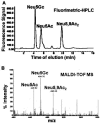Sialic acids siglec interaction: a unique strategy to circumvent innate immune response by pathogens
- PMID: 24434319
- PMCID: PMC3928697
Sialic acids siglec interaction: a unique strategy to circumvent innate immune response by pathogens
Abstract
Sialic acids (Sias) are nine-carbon keto sugars primarily present on the terminal residue of cell surface glycans. Sialic acid binding immunoglobulins (Ig)-like lectins (siglecs) are generally expressed on various immune cells. They selectively recognize different linkage-specific sialic acids and undertake a variety of cellular functions. Many pathogens either synthesize or acquire sialic acids from the host. Sialylated pathogens generally use siglecs to manipulate the host immune response. The present review mainly deals with the newly developed information regarding mechanism of acquisition of sialic acids by pathogens and their biological relevance especially in the establishment of successful infection by impairing host innate immunity. The pathogens which are unable to synthesize sialic acids might adsorb these from the host as a way to engage the inhibitory siglecs. They promote association with the immune cells through sialic acids-siglec dependent manner. Such an association plays an important role to subvert host's immunity. Detailed investigation of these pathways has been discussed in this review. Particular attention has been focused on Pseudomonas aeruginosa (PA) and Leishmania donovani.
Figures






References
-
- Mandal C, Mandal C. Sialic acid binding lectins - a review. Experientia. 1990;46:433–41. - PubMed
-
- Sinha D, Chatterjee M, Mandal C. O-acetylation of sialic acids- their detection, biological significance and alteration in diseases- a review. Trends Glycosci Glycotechnol. 2000;12:17–33.
-
- Mandal C, Chatterjee M, Sinha D. Investigation of 9-O-Acetylated sialoglycocongugates in childhood acute lymphoblastic leukaemia. Br J Hematol. 2000;110:801–12. - PubMed
Publication types
MeSH terms
Substances
LinkOut - more resources
Full Text Sources
Medical
